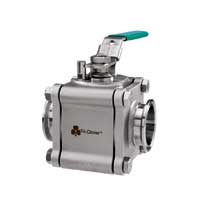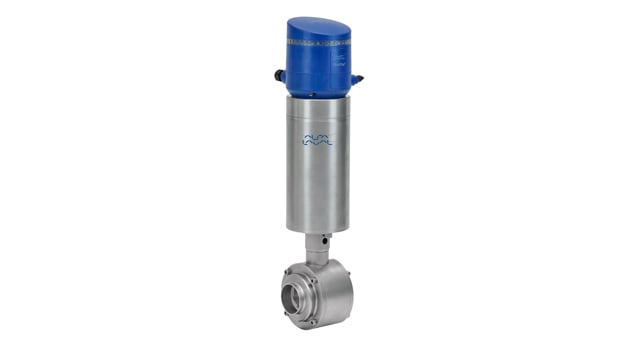Vanne à boule hygiénique SBV
Sanitary ball valves feature a full-bore design that enables full fluid flow with minimal pressure drop, making them ideal for handling viscous liquids or liquids containing particles in the food, beverage, chemical and pharmaceutical industries.
Reliable full-flow performance
Alfa Laval sanitary ball valves (SBVs) are full-bore flow valves that provide on/off control with minimal pressure drop. The valve opening has a constant pipeline diameter, which enables fluids to flow freely through the valves when open. Flow restriction is comparable to that of a straight tube. This makes the SBVs suitable for:
- Handling fluids that are viscous or contain solid, semi-solid or abrasive particles
- Use wherever pigging of process lines is a major consideration
- Applications that require gentle product treatment
- CIP applications
Automated or manual control
For versatility, Alfa Laval SBVs can be supplied for manual or automatic operation.
Manual operation: SBVs feature stainless steel quarter-turn handles to mechanically lock the valves in either open or closed position.
Automatic operation: SBVs use standard maintenance-free pneumatic actuators. Actuated ball valves are delivered as normally closed (NC) valves that are controlled from a remote location by means of compressed air. These, however, can easily be rebuilt to a normally open (NO) configuration. Actuators can be fitted with Alfa Laval ThinkTop valve sensing and control units. Optional inductive proximity sensor and mounting bracket are available.
Compact, simple ball valve design
Easy to build into most any process line, Alfa Laval SBVs feature a straightforward floating ball design, which guarantees a tight seal and permits axial movement while preventing rotation. They are water hammer-safe and completely insensitive to pressure shocks in the pipelines.
Spring-loaded, self-adjusting seal rings provide highly reliable valve stem sealing. SBVs with automated control have inspection holes in the bonnet for easy inspection of the stem seal.
Easy-to-maintain ball valves
The three-piece valve design with few moving parts enables easy access to all valve components, making maintenance quick and easy. Durable PTFE valve seats help prolong service intervals. No special tools required for maintenance.
Sanitary ball valve range
The Alfa Laval sanitary ball valve range consists of two standard valve models.
- SBV with either manual handle or automated operation for applications that involve high operating pressures up to 16 bar and temperatures up to 150°C, and where the use of pigging systems is required.
- Tri-Clover® ball valves for applications that require full flow with minimal flow turbulence and pressure drop. An optional encapsulated seat is available for applications where reducing the risk of potential product entrapment is important.
For more information, please refer to Documentation.
Avantages du produit
- Performances fiables à débit intégral
- Vanne à boule à la conception compacte et simple
- Résistante aux coups de bélier
Catalogue produits

Fonctionnement
Construction
La vanne à boule hygiénique SBV Alfa Laval est composée d'un corps de vanne, de deux brides, de sièges de vanne en PTFE, d'une boule, d'une tige et d'une poignée pour un fonctionnement manuel ou d'un chapeau et d'un actionneur pneumatique pour un fonctionnement automatisé. Pour une inspection et une maintenance rapides et aisées, la vanne se monte et se démonte facilement avec des vis de bride à extrémité soudée.
Principe de fonctionnement
Une boule de précision comportant un alésage ou une ouverture se trouve à l’intérieur du corps de vanne entre deux brides et deux sièges de vanne en téflon.
Options
- Poignée quart de tour pour un fonctionnement manuel ou actionneur pneumatique pour un fonctionnement automatisé
- Platine de montage de détecteurs de proximité inductifs
- Unité de détection et de commande de vanne ThinkTop®
- Raccords conformes à la norme requise (ISO ou DIN)
- Sièges de vanne encapsulés en PTFE
- Raccordements de nettoyage de siège de vanne
- Joints toriques en NBR, Q (Silicone), FPM (Viton)

